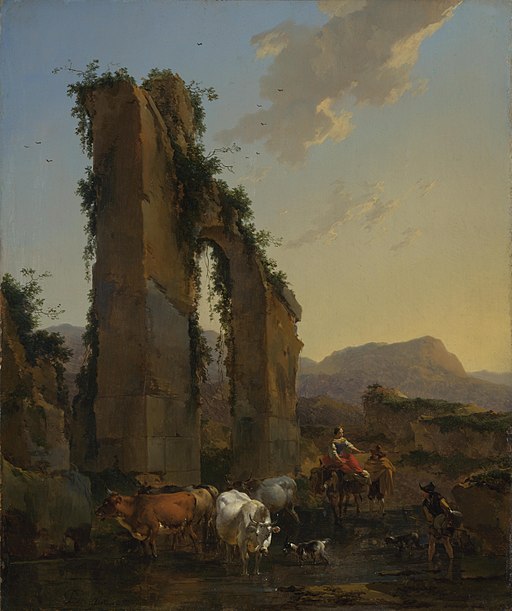
The Three Droves, 1656
Born October 1, 1620 in Haarlem, Netherlands, Nicolaes Berchem was a Dutch landscape painter. Berchem is known for his strong use of light, lush verdant landscapes and elegant figures yet sadly, is not given due attention for his incredible gifts. Berchem was an incredibly prolific painter and also produced many etchings and drawings during his lifetime in Haarlem and Amsterdam. Although not exactly a household name, Berchem was highly esteemed in his day. He taught some of the leading Dutch artists of the Golden Age, including Karel Dujardin, Pieter de Hooch, Jan van Huchtenburg, and Jacob Ochtervelt among others.
In The Three Droves above, Berchem's stunning light bathes this scene in romantic warmth. Judging by the greenish-yellow tone in the sky we see that Berchem glazed it in warm yellows, and the way that tree off to the right is silhouetted against that orange glow is breathtaking. He uses the warm tones as a motif throughout the painting, in some of the livestock, the figures, the path they tread on, and sidelights the various trees in the distance. Look closely at some of the brushwork in the leaves, and one can clearly see Berchem's profound respect for the land and nature. The greens that he uses in the foreground are an astutely rendered warm tone, smooth in certain areas and in others he reveals the leafy grass surrounding the sheep. This may be fantasy, but it is pure heaven...and must be incredibly moving in person.

Landscape with Bathers, 1669 (Landscape by Joris van der Haagen, figures by Nicolaes Berchem)
Berchem here collaborates with fellow Dutch Master Joris van der Haagen, who apparently does most of the landscape. In this lush, gorgeous setting Haagen uses an earthy palette. Warm greens and browns fill the composition, with only the slightest use of red and blue for accents. The main trees on the left are quite possibly some of the most beautiful ever painted. Although not entirely interesting at first glance, look deeper and we see how Haagen dapples his magic light across the leaves toward the left, gradually darkening in shadow toward the right, then finishes with warm, deep umbers backlit from the sun on the trees toward the river. Slowly raise your eyes upward to see just how brilliant this brushwork is in how the greens go from dense, shadow shapes to individual leaves as they soar upward toward the sky. Berchem's figures here are relaxed and painted naturally. It is interesting to wonder how much Haagen worked on the landscape as his style is quite similar to Berchem, and he could have easily painted this scene alone without Haagen.

Peasants with Four Oxen and a Goat at a Ford by a Ruined Aqueduct, ca. 1658
I love the loose brushwork in this painting. Berchem glazes the sky again with yellow, this time with dramatic clouds to indicate perspective and distance. This rather massive arch is in sharp one-point perspective and we can see how Berchem has some fun with the tones and brushstrokes here, alternating greys with warm tones and framing it with delicate vegetation. While travelling in Italy Berchem did several sketches of the Roman countryside and used these as inspiration for his bucolic capriccios with invented ruins. Note how detailed the livestock is painted below. Berchem did several drawings of cows and various other livestock in order to depict his animals accurately. They appear to be standing in a very shallow water, which Bertram suggests a hazy reflection below with various dark and bright tones. Berchem takes ordinary concepts and breathes life into them with his deep respect and love of rural life and nature.

View of the Colosseum in Rome,ca.1680
This pen-and-ink wash clearly shows Berchem's apt attention to composition. His figures are always small in relation to the landscape, yet always busy doing something. Here, the architecture of this crumbling Colosseum offers us a hint of how the ancient world was buried in foliage during the fifteenth and sixteenth centuries...yet piquing the interest of all artists and humanists all over Europe to change the world by inspiration from the past.

Mountainous Landscape with Muleteers, 1658
A stunning work. Minimalist for a landscape of the 17th century, yet its power comes from the late afternoon light fading off to the left of the frame. Although Berchem uses much less foliage than his other works, the attention to detail in these trees is more enthralling. That warm yellow glaze off to the left of the sky here makes the painting. The landscape here is brilliant in composition, leading the eye gently down the sloping valley off to the mountains in the distance. It is here that we can try to humbly imagine here a world without pollution or machinery, or the noise of technology...how that air must have smelled so fresh and invigorating.

Italianate Landscape, 1683
I love the freshness and vivid afternoon light in this work. Berchem uses a beautiful blue sky with dramatic clouds, partially infused with sunlight, that lead our eye to a very cool atmospheric distance. I like how the main trees here are in partial shadow, along with the figures on the road, yet gently struck by the light of the sun in a way that makes us stop to look at them. His method of painting vegetation and grass is inspiring practice for any landscape painter. This contrast between cool and warm, bright sunlight and shadow, makes this work nearly impossible to not admire.
Berchem's love for nature and pastoral life reveals that truism of art that our feelings as artists cannot lie in painting. His work is timeless in that we can immerse ourselves in his majestic countryside and bucolic characters to not only appreciate his world, but hopefully to inspire us to preserve our own as well.
Comments
Post a Comment